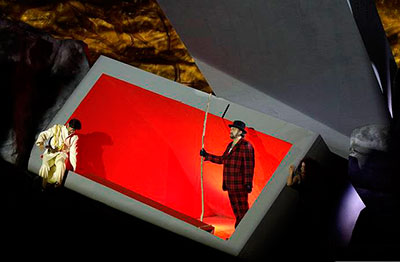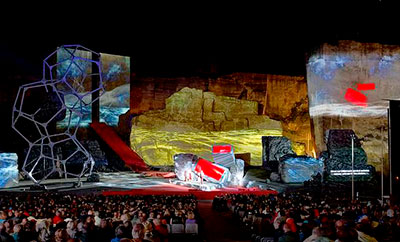
The scope and scale of the production of Verdi’s Rigoletto on Europe’s largest natural stage demanded audio design of similar scope – and faced challenges of similar scale.
The open-air performance at Austria’s St Margarethen Quarry prompted sound designer Volker Werner to adopt Out Board’s TiMax SoundHub spatial audio processing to address both issues.
St Margarethen Quarry is Europe’s largest natural stage – at 65m wide and 25m deep, it has an audience capacity of 4,700. For Werner, the choice of TiMax was essential: ‘One reason is to have the possibility to achieve accurate localisation of the singers for as many listeners as possible,’ he says. ‘Another reason was that the stage is a huge 100-ton steel structure, the whole of which is 3D-mapped and projected on with 16 high-power projectors. The open design gave very few possibilities to hide large speaker systems.’

Adding a further level of complexity and challenge to the spatial reinforcement system’s design is the movement of the loudspeakers on stage. Speaker cabinets are integrated into the scenic structures adorning the stage, and as these move at scene changes – in some cases during the performance, the audio mapping changes accordingly.
‘With TiMax we blend the delay/ level settings for those speakers while they are moving to keep the acoustic experience for the listeners consistent,’ Werner says.
The sound design uses multiple speaker systems distributed across the stage area, all hidden from view within the stage and scenery. Approximately 60 speakers serve the stage, with 12 front fills in ‘cross-fire’ pairs, and a further 25 speakers in crossfire pairs or triplets, all with a narrow coverage of around 40°, serve vocal localisation.
These are delayed and levelled individually for multiple ‘source zones’ on the stage, relating to the areas from which the singers perform. ‘If a singer sings in the zone in front of one of the localisation speaker systems, all the speakers in that cluster play with zero delay,’ Werner explains. ‘To the right of the zone, only the speakers pointing right play delayed – and the same to the left: only the speaker pointing left is added and with this we try to reduce “wrong localisation” as much as possible.’
Out Board Director Robin Whittaker,was on site during setup to assist in the alignment and fine-tuning of these spatial reinforcement and acoustic ambience enhancement TiMax objects.
The remainder of the speakers reinforce the orchestra and provide enhanced coverage for the rear rows of the auditorium. Four line array systems and front fill systems, serve the orchestra reinforcement, with a further two line array systems delayed in zones and reduced in livel by 3-4dB enhance rear audience coverage.

As well as vocal localisation, TiMax is employed as a multichannel playback and immersive surround system, delivering enveloping sound effects plus playback of certain parts of the stage-band score, and even some pre-show and safety announcements. The stage band is pre-recorded and played back as though coming from the back left of the stage.
The surround effects system is also mapped in TiMax to create a virtual opera hall acoustic ambience around the audience. Early reflections are created for each source-zone individually and some longer reverberation added by external reverb engines spatially blended and similarly aligned to the surround and stage speakers. Special moving reverb effects are also rendered in TiMax, including a ghost singing offstage and ambient sounds flying around the audience.
At the core of the St Margarethen audio system are two TiMax2 Soundhub-S48 spatial processor units in a redundant set-up, with Dante connections from a Studer Vista 5 SR FOH console.
The lead actors use DPA microphones and were double-miked for redundancy, while the choir singers are single miked with Sanken microphones. The orchestra and off-stage choir use wired Schoeps microphones. Loudspeakers are a mix of d&b audiotechnik for on-stage and delays, powered by D12 and D80 amplifiers and remote-controlled on an R1 network, while surrounds are provided via multiple Bose weather- resistant enclosures.
‘With TiMax SoundHub, we were easily able to create a flexible, high-channel count, directional acoustic reinforcement system using dynamically managed precedence. We had great support from TiMax during the phase of system-tuning in a very limited time-frame,’ Werner concludes.
More: www.outboard.co.uk